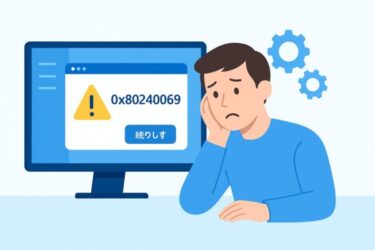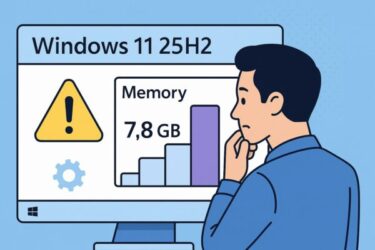
- 1 What is 0x80240069?
- 2 Symptoms you may see
- 3 Initial checks (2–5 minutes)
- 3.1 Step 1 — Run the Windows Update troubleshooter
- 3.2 Step 2 — Reset Windows Update services & caches
- 3.3 Step 3 — SFC and DISM
- 3.4 Step 4 — Network, proxy, VPN, and DNS checks
- 3.5 Step 5 — Install from a local .msu
- 3.6 Step 6 — Check for WSUS/enterprise policy leftovers (common on reused PCs)
- 3.7 Step 7 — In-place repair (ISO) to rebuild components
- 4 Deep-dive tips (optional but powerful)
- 5 FAQs
- 6 Prevention
- 7 Summary
What is 0x80240069?
It signals that Windows Update couldn’t proceed due to update component inconsistencies: broken caches, stuck services, policy leftovers, or network/proxy interference. It often shows up on 25H2 (e.g., KB5066835) when the progress bar keeps looping after “Retry.”
Symptoms you may see
- “Downloading…” completes, but installation fails with 0x80240069.
- Repeated Retry still ends with the same code.
- The .msu also stalls unless run in Safe Mode or from a local path.
- Update history lists Failed entries with this code.
Initial checks (2–5 minutes)
- Free space: ensure C: has ≥10 GB.
- Unplug USB drives/printers/capture cards.
- Pause non-Microsoft AV and overlays (screen recorders, stream tools).
- Reboot once and try the update again.
Step 1 — Run the Windows Update troubleshooter
Settings → System → Troubleshoot → Other troubleshooters → Windows Update → Run.
Reboot when done and try again.
Step 2 — Reset Windows Update services & caches
Run PowerShell (Admin) and paste:
net stop wuauserv
net stop bits
net stop cryptsvc
ren C:\Windows\SoftwareDistribution SoftwareDistribution.old
ren C:\Windows\System32\catroot2 catroot2.old
net start cryptsvc
net start bits
net start wuauserv
Reboot → Check for updates.
Step 3 — SFC and DISM
Run:
sfc /scannow
DISM /Online /Cleanup-Image /RestoreHealth
Reboot after SFC repairs; repeat SFC until it reports no integrity violations.
Step 4 — Network, proxy, VPN, and DNS checks
0x80240069 is sensitive to network layers. Work through these:
- Disable VPN and any corporate proxy temporarily.
- Settings → Network & Internet → Proxy: ensure only Automatic detect settings is on.
- Test with alternative DNS (1.1.1.1 / 8.8.8.8).
- Confirm system time & date are automatic; certificate checks fail if the clock is off.
- If you can, try a different connection (mobile tethering) to isolate ISP/firewall issues.
Step 5 — Install from a local .msu
- Download the correct KB package for your build.
- Save the .msu to your Desktop.
- Double-click to install (or run in Safe Mode if it hangs).
Avoid running .msu directly from a network share.
Step 6 — Check for WSUS/enterprise policy leftovers (common on reused PCs)
Some consumer PCs previously joined to a domain keep Windows Update for Business/WSUS registry values that force updates to a non-existent server.
- Settings → Accounts → Access work or school: remove stale connections if you are not managed.
- Registry to inspect (backup first):
HKLM\SOFTWARE\Policies\Microsoft\Windows\WindowsUpdate
IfWUServer/WUStatusServervalues exist on a home PC, they can block updates. - If editing the registry feels risky, create a new local/Microsoft account and see if updates work there; migrate later.
Step 7 — In-place repair (ISO) to rebuild components
Mount the latest Windows 11 ISO → run setup.exe → Keep personal files and apps → proceed.
This refreshes update components and resolves stubborn 0x80240069 cases without a clean install.
Deep-dive tips (optional but powerful)
- Services: verify Windows Update / BITS / Cryptographic Services / Windows Modules Installer are Running.
- Event Viewer: check Windows Logs → Setup/System for failure clues.
- WindowsUpdate.log:
Get-WindowsUpdateLog(Creates a readable log on your Desktop.) - Storage:
chkdsk /scan, free space, SSD firmware updates. - AV conflicts: fully uninstall, reboot, update, then reinstall.
FAQs
Q:Is 0x80240069 a server-side issue?
A:Occasionally—but most cases are local component/network/policy problems you can fix with the steps above.
Q:The update works on a different account—why?
A:Your original profile may carry policy leftovers or per-user proxy settings. Migrate to the clean profile after verifying.
Q:Safe Mode needed for .msu?
A:If drivers/AV keep interfering, Safe Mode (no networking) can let the package install cleanly.
Prevention
- Keep drivers (especially chipset/storage/network) up to date.
- Avoid running multiple security suites at once.
- Keep free space healthy; schedule monthly housekeeping.
- Before Patch Tuesday, make a restore point/system image.
- If you used WSUS in the past, ensure policies are cleared when converting a machine to home use.
Summary
Error 0x80240069 usually comes down to broken update components or network/policy interference. Reset WU, repair integrity, clear proxy/VPN hurdles, run the local .msu, and remove WSUS leftovers. If all else fails, an ISO repair install puts you back on track—without losing files.
Related Articles
・How to Fix KB5064403 Installation Error on Windows 11 (22H2 / 23H2)
・Windows 10’s Final Cumulative Update: How to Install KB5066791 Safely
・October 2025 Windows Update May Cause SATA SSD Detection Issues — What’s Happening and How to Fix It


